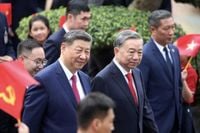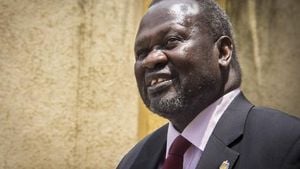Chinese President Xi Jinping’s recent visit to Vietnam on April 14-15, 2025, amid escalating tensions between the United States and China, is a significant diplomatic maneuver that underscores Vietnam's commitment to its national interests while navigating the complexities of global economic pressures. The timing of Xi's visit is particularly notable, as it occurred just days after U.S. President Donald Trump announced sweeping global tariffs, including a proposed 46 percent tariff on Vietnamese goods.
As Vietnam finds itself caught in the crossfire of the ongoing U.S.-China trade war, Xi’s visit serves multiple purposes. It not only seeks to strengthen bilateral relations but also to signal to Washington that Vietnam is not merely a pawn in this geopolitical chess game. In fact, Xi has cautioned Hanoi against making concessions to the U.S., framing his visit as an opportunity for Vietnam to bolster its economic ties with China.
During Xi’s Southeast Asian tour, which follows China’s Central Conference on Work Relating to Neighboring Countries held on April 8-9, 2025, the Chinese leader emphasized the importance of regional cooperation and friendship. This tour is part of a broader strategy by Beijing to position itself as a more favorable partner in the region, especially as U.S. influence appears to wane under Trump's administration.
Vietnam, under the leadership of the Vietnamese Communist Party (VCP) and its new leader, To Lam, is keenly aware of the need for strategic stability in its external environment. With internal political transitions underway and the 14th National Party Congress approaching, Vietnamese leaders recognize that their ambitious reform agenda hinges on maintaining a stable relationship with China. This is not merely a reaction to U.S. tariffs, but a proactive approach to safeguard Vietnam’s security and development.
Vietnam's development strategy has long relied on an export-driven economy, characterized by cheap labor and low-cost land. However, the pressures from Trump's tariffs have highlighted the necessity for a shift towards a more resilient growth model. Xi's visit presented Vietnam with a critical opportunity to secure Chinese support for this transformation, which is now focused on enhancing investment-led growth and technological innovation.
During the visit, multiple cooperation agreements were signed, covering key areas such as road transport, energy infrastructure, seaports, logistics, and aviation. Notably, the establishment of a joint committee on railway cooperation aims to construct cross-border railways linking China to major cities in northern Vietnam, with Chinese technical assistance and concessional loans. This reflects a subtle shift in Vietnam’s approach to China’s Belt and Road Initiative, moving towards a more collaborative stance.
Moreover, Vietnam is placing significant emphasis on technology transfer and capacity building, aiming to integrate its firms into high-value supply chains in sectors where China already excels, such as high-speed railways and artificial intelligence. The Vietnamese government is nurturing national champions like Viettel and FPT in technology, and VinFast in electric vehicles, seeking to elevate these companies from mere technology adopters to innovators capable of capturing greater market value.
Despite the potential benefits, challenges remain. There are concerns about the risk of Vietnam's market being inundated with Chinese products, especially as Chinese firms face increased scrutiny and restrictions in the U.S. market. Additionally, Beijing's hesitance regarding technology transfer poses a significant hurdle for Vietnam's aspirations to enhance its technological capabilities.
However, the willingness of Vietnam to deepen its economic ties with China, as evidenced during Xi’s visit, indicates a level of political courage and trust in the current Vietnamese leadership that has not been seen in recent years. This strategic pivot is not merely about choosing sides; rather, it reflects Hanoi's ability to balance relations with major powers while prioritizing national development.
The significance of Xi's visit lies in its implications for the future of Vietnam-China relations. It serves as a litmus test of Vietnam’s diplomatic strategy, which seeks to align external partnerships with domestic priorities. The overarching goal remains clear: to cultivate stability, promote development, and enhance internal resilience while engaging all partners on terms that serve Vietnam's national interests.
As the region witnesses a shift towards a less U.S.-centric Asia, driven by factors such as Trump's trade war and China's assertive diplomacy, Vietnam's approach will be closely watched. The question is not merely about which direction Vietnam will lean, but how deeply its roots are anchored in its strategic vision for the future.
In conclusion, Xi Jinping's visit to Vietnam marks a pivotal moment in the evolving dynamics of Southeast Asia, where nations are increasingly navigating a complex web of international relations. For Vietnam, the challenge will be to leverage its relationships wisely, ensuring that its development goals are met while maintaining a balanced stance in the face of great power competition.





